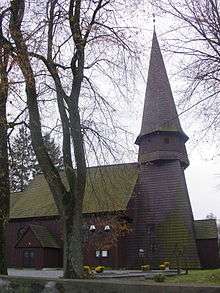Leśno, Chojnice County
Leśno [ˈlɛɕnɔ] is a village in the administrative district of Gmina Brusy, within Chojnice County, Pomeranian Voivodeship, in northern Poland.[1] It lies approximately 8 kilometres (5 mi) north of Brusy, 30 km (19 mi) north of Chojnice, and 77 km (48 mi) south-west of the regional capital Gdańsk. The village has a population of 669.
Leśno | |
|---|---|
Village | |
 Leśno | |
| Coordinates: 53°56′58″N 17°42′0″E | |
| Country | |
| Voivodeship | Pomeranian |
| County | Chojnice |
| Gmina | Brusy |
| Population | 669 |
History
In the near vicinity of Lake Leśno Dolne is an archaeological site called Kamienne Kręgi (English: "Stone Circles") which contains numerous barrows and cists. Some are dated back as far as the Bronze Age. Other, later, barrows are dated back to the 1st and 2nd centuries AD, and are connected with Gothic settlement.[2]
The village of Leśno first appears in the records for the year 1342, in which Winrich von Kniprode, master of the Teutonic Knights, granted it to one "Dytryk" for services to be rendered.[3] In the time of the Partitions, Leśno, like all of the surrounding region, became part of the Prussian Empire. From 1919 to 1939, during the Second Polish Republic, it was included as a part of Poland. After the German conquest of 1939 it was part of Reichsgau Danzig-West Prussia. During the German occupation, the resistance organization Gryf Pomorski (English: "Pomeranian Griffin") maintained a radio station named "Budnik" ("Alarm Clock") in the nearby hamlet of Widno.[4]
Kashubian Emigration to America
Leśno has long been considered a part of the Kashubian culture. During the Kashubian diaspora, many families from Leśno such as the Bambenek (Bambeneks) and the Stoltmann (Sztoltmans), Spierewka (Sprouffske), Bielawa emigrated to the area of Winona, Minnesota in the United States, beginning in the late 1850s.[5]
For further details on the history of the region, see History of Pomerania.
Church of the Exaltation of the Holy Cross

The Church of the Exaltation of the Holy Cross in Leśno dates back as far as 1643 and has the highest wooden tower in Poland. First mentioned in 1534 as the church of Saint Katarzyna, the historical work Ad Historiam Ecclesiasticam Pomeraniae states that it was refounded and given its present name by Queen Marie Louise Gonzaga of Poland circa 1642.[6]
Miraculously, the Church of the Exaltation of the Holy Cross escaped major damage during the First and Second World Wars. Indeed, many of the antique fittings have been preserved and can be viewed today. In keeping with its architectural and cultural significance, the church has received careful restoration and renovations. In 1975 the altars, pulpit, and choral area were renewed. In 1993-1994, the roof and tower coverings were renewed.
References
- "Central Statistical Office (GUS) - TERYT (National Register of Territorial Land Apportionment Journal)" (in Polish). 2008-06-01.
- Leśno Barrow Cemetery
- Slownik Geograficzny Krolestwa Polskiego (Warsaw 1884)
- A. Gasiorowski and K. Steyer, Tajna Organizacja Wojskowa Gryf Pomorski (Gdansk 2010), p. 131.
- "First Settlement in Winona: 1859 – Bambenek.org". bambenek.org. Retrieved 2017-07-21.
- Miasto Brusy official website
